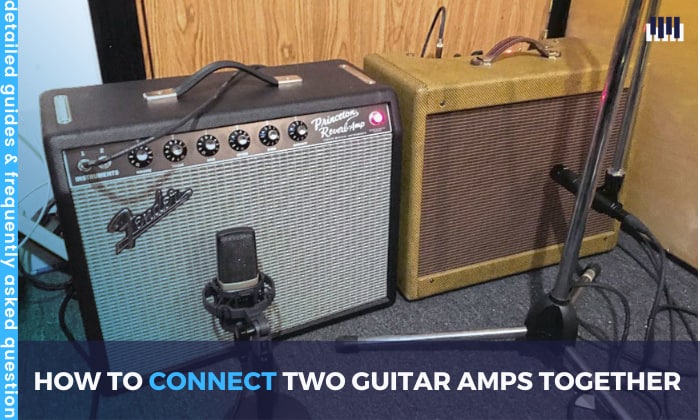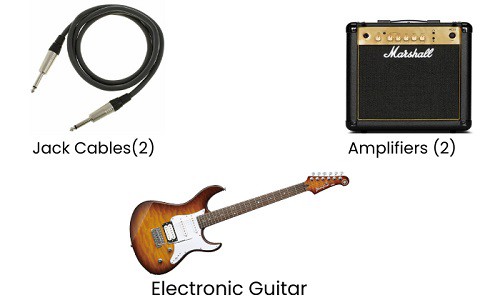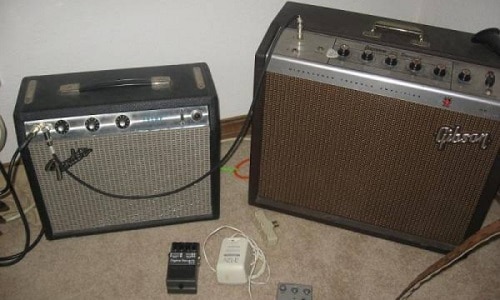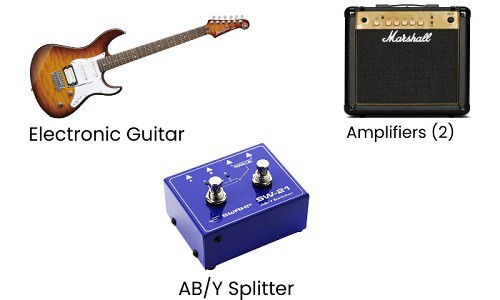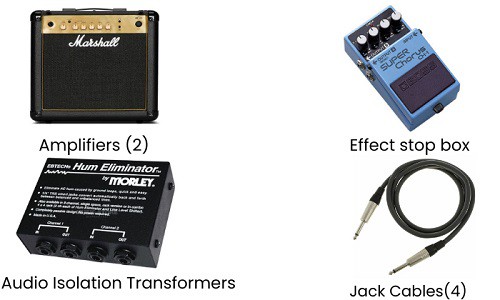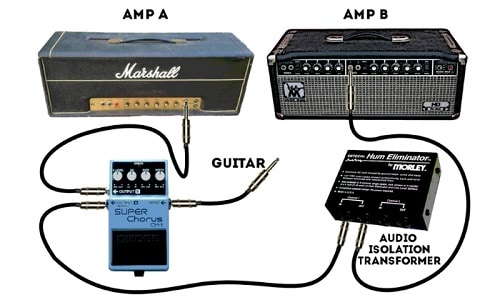Many people often wonder whether it’s both doable and safe to run two amps together. If you think running two guitar amps in stereo at once is complicated, then this guide will benefit you. For guitarists seeking to broaden their musical horizons, linking two guitar amps can open doors to a world of creative potential.
Whether you aim to create a more immersive live sound or strive for a unique studio recording, various effective ways exist.
Check out these steps on how to connect two guitar amps together. Get ready to enjoy a whole new level of musical experience.
Table of Contents
Ways to Connect Two Guitar Amps Together
Method 1: Daisy chaining method
To start off, if you’re looking for an easy-peasy method to hook two amps together, then this is the one you’re looking for. There are only five (4) steps that you need to follow, so buckle up.
Tools:
- Jack Cables (2)
- Amplifiers (2) – For your convenience, we suggest buying a guitar amp with two or more inputs, like Marshall amps.
- Your electronic guitar
Step 1: If one of your amplifiers has one input and the other has multiple, plug your guitar into the multiple-input one.
If both your amplifiers have two inputs (or more), feel free to plug your guitar into either of the amplifiers.
Step 2: Connect the two jack cables:
- First cable: Hook one end into the guitar’s output and plug the other end into the first amp’s first input.
- Second cable: create a daisy chain guitar amp by plugging the second cable into the first amp’s second input. Hook the other end into the second amp’s first input.
Method 2: AB/Y Splitters
Tools:
- Your guitar
- 2 amplifiers
- An AB/Y splitter
- This simple diagram
Take a moment to understand the AB/Y splitter. It functions like an effects pedal, letting you send your guitar sound to two places.
Step 1: Plug your guitar’s cable into the splitter’s input jack, often labeled as “Input” or “Guitar In.”
Step 2: Now, this instrument cable splitter has two output jacks, usually named “A” and “B.” Connect a cable from the “A” output to the input of the first amp and do the same with the “B” output to the second amp.
Step 3: Switch on both amps and start playing your guitar with everything connected. You’ll hear your guitar sound coming from both amps. Play around with each amp’s volume and tone settings until you get the mix you like.
Step 5: Keep an ear out for any differences in sound or changes in tone that the guitar signal splitter might cause. If something’s off, adjust your setup until you’re happy with how it sounds.
Note: Opt for a buffered AB/Y Splitter for signal quality. Consider reliable options like the Orange Amp Detonator.
Method 3: Guitar effect stop box
Tools:
- 2 Amplifiers
- An effect stop box – Make sure to they have two outputs designed for splitting your signal.
- Audio isolation transformers
- 4 Cables
- And a diagram for connecting
Step 1: Cable 1: Connect your amplifier A’s input to the effect stop box’s first output.
Step 2: Cable 2: Connect the stop box’s second output to the audio isolation transformer’s input.
Step 3: With cable 3: Connect the audio isolation transformer’s output to amplifier B’s input.
Step 4: Connect the effect stop box’s input to your electronic guitar to complete the dual amp setup.
Can You Plug 2 Guitars Into 1 Amp?
You certainly can, and you will be surprised that it’s actually safe to use one amplifier for multiple guitars.
You can also stack the amp, but make sure the amplifiers are compatible.
Conclusion
Understanding how to connect two guitar amps together expands greater possibilities for musicians in terms of music and sound. Whatever method to wire two amps you use, these techniques allow guitarists to infuse their music with depth and dimensions.
The sound it produces is superb in that it’ll make you enjoy singing along while in a car. So, whether you’re after a richer sound or to beautify your performance, these methods provide the means to make it happen.

Sam Stephenson is a writer who grew up in Washington, North Carolina. He was 2010 and 2015 ASCAP Deems Taylor / Virgil Thomson Prize winner and a 2019-2020 Guggenheim Fellow in General Nonfiction. His books have been published by W.W. Norton, Alfred A. Knopf, and Farrar, Straus and Giroux
